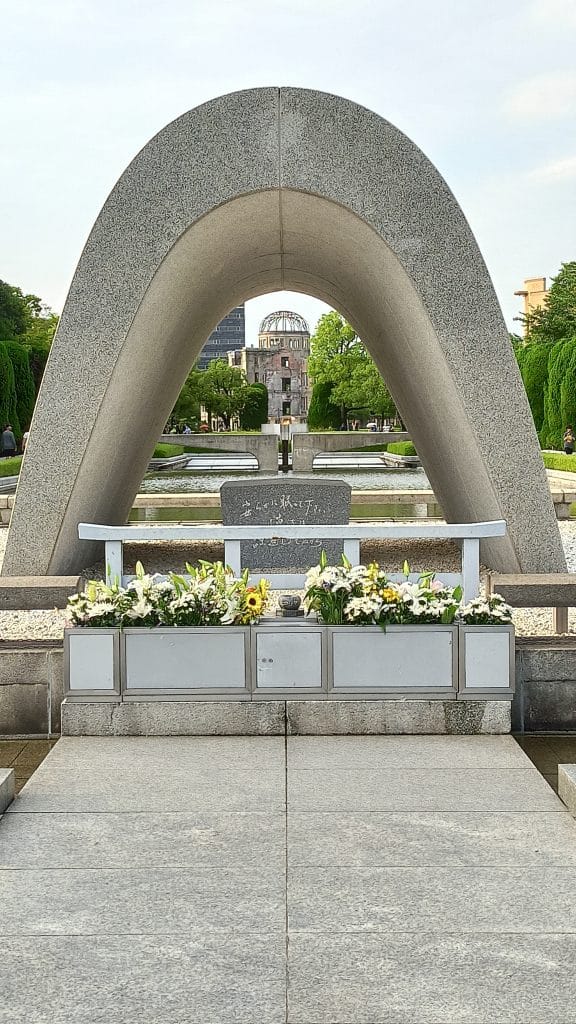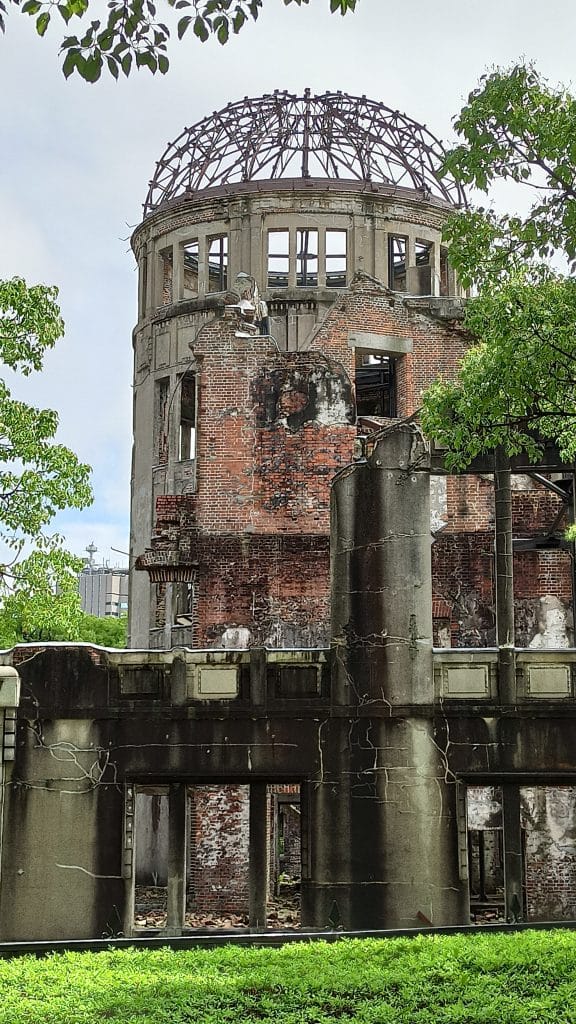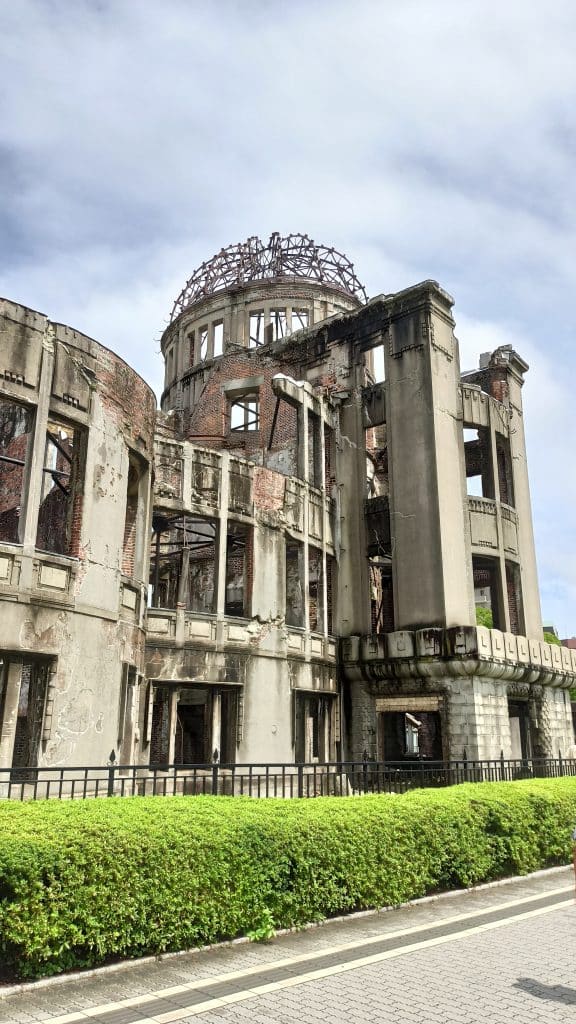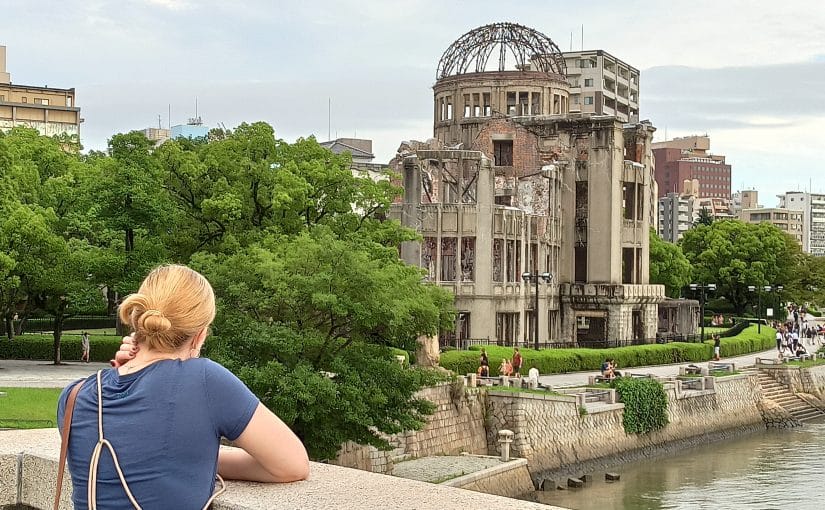I’m not sure how to write about this experience, what I saw or what I read here today. I feel lucky that I don’t understand how people can inflict such suffering and devastation on others. It goes against what I assume, perhaps wrongly, every person has inside them, a natural morality to do what is good. Seeing the photos of burnt bodies, the clothes with brown blood stains and black radio-active rain drops over them is sobering in the extreme.
No one is talking as we walk through the museum. We were surrounded by people, all walking slowly in a dark corridor, almost completely silently. It’s a long corridor with one huge black and white image at the end. It’s a girl in a tattered dress with burns over her face and arms and singed hair. She’s looking straight down the barrel of the camera as you walk towards her, into the exhibition.
It started with photos from 1 or 2 years before the explosion. Normal life, really mundane images that suddenly became really important after 6th August 1945 as a record of what used to stand here. Because the next image you see is a floor to ceiling panorama photograph from the centre of Hiroshima after the bomb hit. There is nothing but rubble in all directions. Only the strongest tree trunks are sticking up here and there, all leaves and boughs blasted off. A couple earthquake resistant steel and concrete buildings remain semi-standing for now, soon to be demolished. But the city is just flat rubble in all directions.
I can’t write out all the accounts of the injuries, wounds, deaths and radiation illnesses. You need to come and see for yourself, as hard as it is to look at. There are some horrendous photographs taken and displayed here. The caption beneath one, showing bodies laying on the bridge, spoke of how the photographer raised his camera to document the scene. But he could not see through the viewfinder for the tears in his eyes. 20 minutes later he took his first photo.
The images show people with burns across huge areas of their bodies and heads. There are also artworks done by survivors that depict scenes before a camera arrived. Many talk of disturbing scenes of people walking through the wreckage, looking for water to stop the burning of their skin, it hanging from their bodies in sheets. The artworks, not done by professionals are (self acknowledgedly) crude, but this makes it even more gruesome that they have taken time to extract these painful and clearly horrific memories. One extract of a diary of a surviving woman said she found her child gasping and calling for water, and that when she responded she would go and get some, all the others around her called out for some too. She came back with water to find her child and all the others dead. She wet each of their lips with the water and prayed for them.

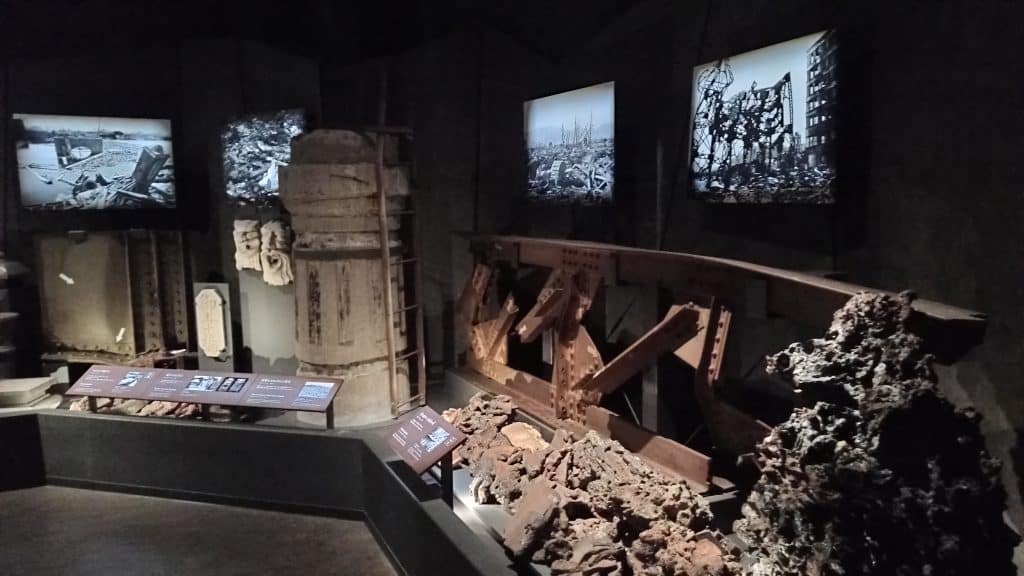
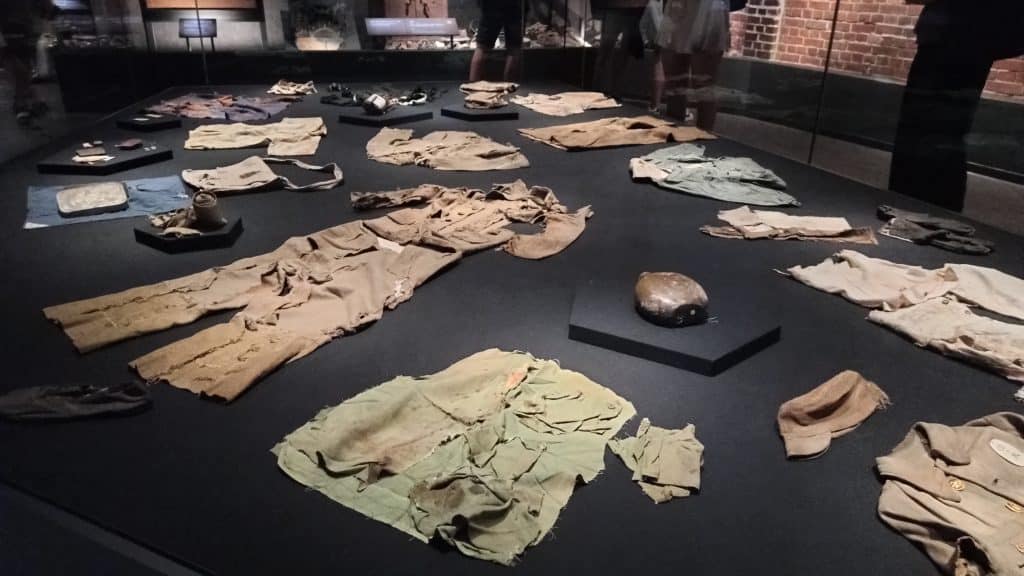



The exhibition also showed the damage to buildings. Examples of thick metal girders bent and twisted, melted stacks of glass jars or piles of coins. There were examples of roof tiles where you could see the normal tile surface, hidden under the overlapped tile above next to the area exposed to the blast with a lumpy, glassy surface. The epicentre of the nuclear explosion is estimated to have reached over 4000°C. This heat literally melted the clay and turned it to glass.
There was a set of stone steps that had been the entrance to a bank. Someone was sitting upon these steps, waiting for it to open that morning when the blast completely vaporised them. It left a dark shadow of their body where they had shielded the stone from direct exposure. The flecks of quartz in the stone surface had burned away leaving lighter coloured stone below. It was like seeing a shadow of a person without them there to cast it. You could see where their legs and feet had been on a lower step, with a larger shadow above. Imagine them sitting there, resting on their knees, watching normal life happen, and then the blast.
The last section of the exhibition hall dealt with the enduring effects of the bomb. How people within 1 km all died, either immediately or within a few days as the radiation shut their bodies down. A few km out, people lasted longer, even started to recover from their burns, but then all their hair dropped out, they got diarrhoea, black “spots of death” under their skin and on their tongue and died coughing up blood. People 5 or 6 km out survived, recovered from the burns, and led lives plagued by painful keloids, recurring cancer diagnosis, mutations and multiple surgeries to attempt to heal bodies irreparably damaged. There were some harrowing stories here of the pain that lasted decades after the initial explosion.
We reached the end of the dark and winding exhibition and turned a corner into a bright viewing gallery. The museum is built in a long, thin, raised concrete box, overlooking the peace memorial gardens. It is aligned with the Memorial Cenotaph and Peace Flame and in the distance, the Atomic Bomb Dome. This structure is now iconic, atop the remains of the Hiroshima Prefectural Industrial Promotion Hall. It was 160m laterally and 600m vertically away from the detonation point of the bomb. Most of the explosive force bore down on it from directly above leaving a lot of main structural walls intact. It’s now preserved as a monument and reminder of the devastation this weapon wrought, but also the uncrushability (if you’ll allow me some literary latitude) and persistence of the human spirit to survive and grow again. All of the Mazda car company’s employees were killed, but they are a world recognised brand today, still based in Hiroshima.
We took a moment to sit here and contemplate what we had seen while looking out at the bright sky and peaceful garden. It is so hard to imagine the whole area flattened. The mountains are so far away. It happened just 78 years ago which is not very long at all. There are so many buildings now as was then. The thousands of people that live and work here. Its a difficult thing to think about and I share that several times this day I was close to tears. Many visitors were.
As we head towards the exit from the viewing gallery, there is a small information stand with two photos. One of the little girl we saw on the way in, and another of a middle-aged woman. This is the same person. She survived, married, had children and then died prematurely, aged 41, from leukaemia. This happened to a lot of survivors, they lived a half life.
We had thought this was the end of the museum, but we entered another section explaining all about the bomb itself, how it was developed, some political artefacts, the nuclear arms race and the global movement towards disarmament.

I’ll not go into detail about this part except for one thing. There was a model of a black cube sitting on a plaque. It’s about the size of 8 sugar cubes stacked to make a big sugar cube. It represents the estimate that less than 1kg of Uranium 235 actually underwent fission out of the 50kg that was delivered by the bomb. That was all the material needed to bring so much destruction. The rest was atomised and scattered across the city in a fine radioactive dust. This is what caused the decades of suffering after the initial blast, as if that wasn’t enough.
We spent some time here learning about it all, but in our UK education of WW2 I don’t think it’s ever been explained why Japan entered the war or the geo-politics that lead to it. This is clearly a gap in our knowledge that needs to be filled to understand what was going on in Japan at the time. Both of us have some homework to do.
Leaving the museum feeling very sober, we headed for some food and stumbled across another Okonomiyaki restaurant. Its a Hiroshima speciality and something we really both like. Especially because it basically doesn’t use any oil or grease, so it tastes very fresh and the abundance of cabbage makes it pretty good for you too.
We next headed for the Atomic Bomb Dome and the adjacent building called Hiroshima Orizuru Tower. Now this tower is what I would describe as good architecture. True, it doesn’t have to be a train station at the same time, but it performs excellently at its primary purposes; to be a viewing platform and offices. Cleverly, the office part is completely segregated from the tourist part and so you’d never know it existed unless you worked there. And then the viewing platform has to be my absolute favourite one so far this trip (altho Marina Bay Sands in Singapore is coming up next, so it may not hold this title for long)
Once you arrive at the top, there is a large open bar area which leads to a wide set of wooden steps. You can only see a wooden slatted ceiling above you as you climb them, until the top step reveals 3 sides of the building open to the view. Its a full panoramic view, with only a few discrete columns of wood supporting the wooden ceiling that lifta up and away towards the edge. Not only the panorama, but you are standing atop a shallow wooden pyramid allowing everyone (if there was a crowd) to see out simultaneously. The symmetry of the floor and ceiling moving away from eachother about the plane of your eye makes the view just pop out wonderfully. Its especially refreshing not to have tall barriers or glass at the edge, but instead a normal height, frameless glass balustrade, half a meter gap and ivy plants growing in pots to soften the edges. There is a nearly uninterrupted view in all directions. As a safety precaution thin steel wire diamond shaped mesh is used which is so unobtrusive it pretty much disappears.

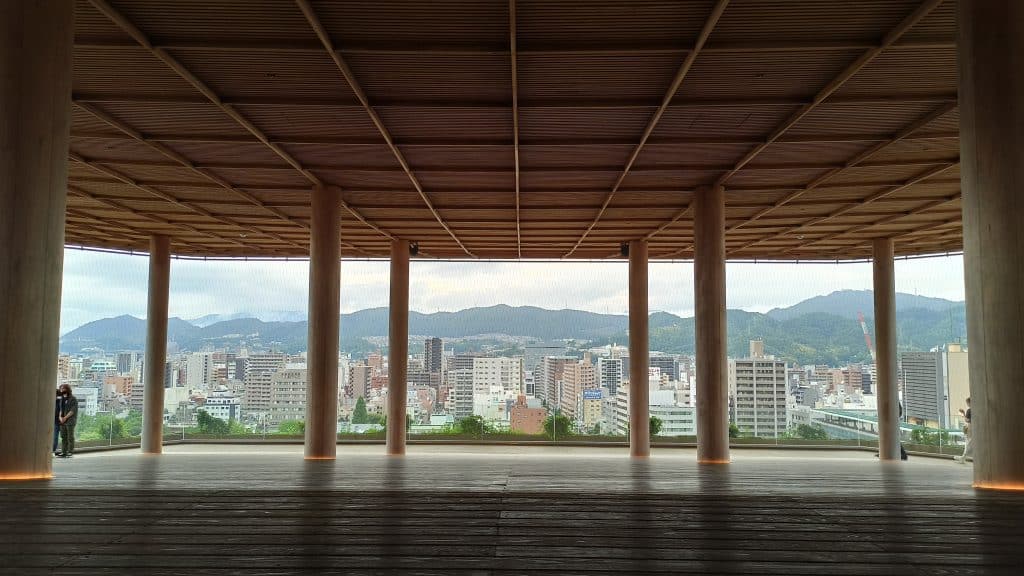



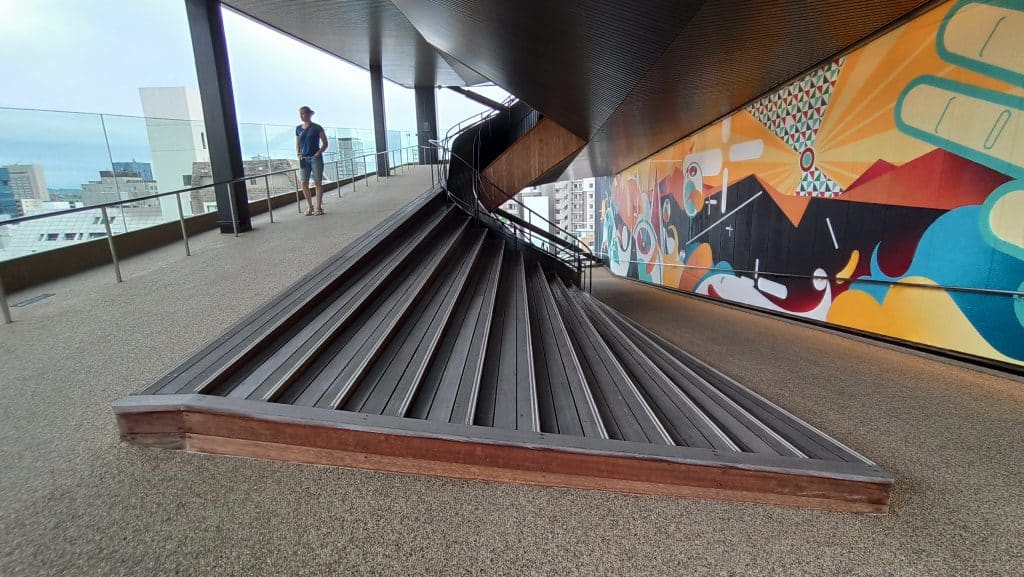
We had a good marvel at the view and looked down on the dome from above, seeing all the rubble at its feet. This monument protects this view, so it will never be built upon. The viewpoint tower therefore doesn’t need to race the other buildings to be the highest, so its not. In fact right behind it, is a much larger tower, but this is blocked cleverly by the 4th side of the tower wall covered in large mirrors. Sitting on the pyramid decking we chatted about what we had seen and how it related to the view before us, beautiful piano music in the background. It was a very calming and inspiring moment that lifted my mood back up. I suspect this was intended.
The Hiroshima Orizuru Tower is not just a boring lookout point for adults, there is a 12 story helta-skelta slide down the back side of the building. This is built into a walkway ramp that descends all the way to the ground at a very natural, easy gradient. Its possibly the most enjoyable way to leave a tower block yet. The walls, again, are open to the views and the main building wall has giant murals painted by local artists offering their wishes for the future of Hiroshima. The side was a bit sticky and really didn’t slide at all, but it’s not designed for a 6ft 2in hairy hunk of a man, so I’ll let them off. I’m sure it’s great fun for kids.
We finished the day walking through the Peace Memorial Park looking at the various monuments and memorials to the people killed, injured and who suffered from the atomic bomb. It was nice to stroll around in the evening sun discussing things we felt about the day. By the end, I was feeling thankful that we are together, Hiroshima has recovered and prospered since, and that because of blunt and truthful display of the horrors the bomb created, people are aware of what life would be like if this ever happened again. Lets hope that leaders of nuclear weapons holding countries understand the misery they will cause at the push of a button, and that they never do it.


